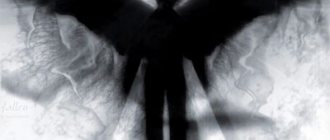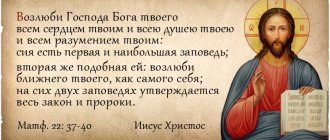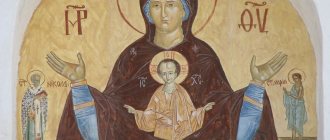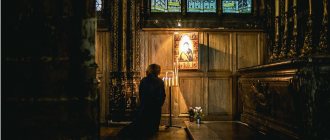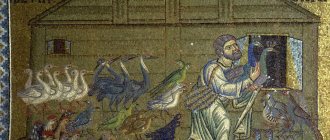The meaning of the Orthodox cross
The cross is the confession of faith of Orthodox Christians. It recalls the suffering of the Savior on the cross, which He endured to save sinners from hell and return to the Kingdom of Heaven. In general, death on the cross was considered the most terrible and shameful death. Men who committed a particularly serious crime indulged in it. On the cross, the hands and feet were nailed. Death occurred from suffocation, heart rupture and blood loss. They died on the cross painfully for long hours, and sometimes even days.
M. Gibson's film “The Passion of the Christ”
Christ chose the most painful death in order to take upon himself the sins of all mankind. Now sinners can repent to Him and receive forgiveness right there, thanks to such a terrible sacrifice of Christ. People do not fully realize the importance and greatness of the Savior’s feat for their sake. As well as the fact that the torment on the cross looked much more terrible than it is shown in icons, paintings and even Hollywood films.
Everyone knows M. Gibson's film "The Passion of the Christ" , which is simply impossible to watch due to the abundance of bloody scenes and torment. But even he could not convey the full horror of Christ’s suffering. On the cross the people were completely naked, and everyone was looking at them. Before this, Christ suffered severe beatings and scourging, so His body turned into a bloody mass. Then He carried the crossbar from the cross to Golgotha.
In order for the arms to stay on the crossbar, they were stretched, as a result, the joints of the arms were dislocated. In addition to the pain from the nails and dislocation, He experienced terrible suffocation and thirst. He had to constantly move to get air. He didn't hang motionless like in the movie. He was dehydrated, his pulse rose to 200, his blood pressure dropped to 70 over 40. Christ experienced vascular collapse and severe heart failure. He had severe convulsions. In addition, He experienced God-forsakenness; the Heavenly Father turned away from Him. This, perhaps, was the most terrible torment for Him.
Christ experienced all this in order to take upon Himself the sins of all mankind, so that we could enter the Kingdom of Heaven . In such suffering for people, one can see not only enormous patience, but unspeakable love. After all, He took all this upon Himself voluntarily!
That is why the cross as a symbol speaks volumes to believers. The Orthodox treat him very reverently. You cannot, for example, depict crosses on the floor, so as not to accidentally step on them. In every home, believers have a crucifix to which they bow and kiss.
Therefore, believers make the sign of the cross as often as possible as a sign of veneration for the Savior’s suffering on the cross. The Apostle Paul wrote: “for the Jews the cross is a temptation, for the Greeks it is foolishness, but for us it is God’s power and wisdom,” also: “I carry the deadness of the Lord in my body.”
History of the Sign of the Cross in the Christian Church
We all know very well what an exceptional role the sign of the cross plays in the spiritual life of an Orthodox Christian. Every day, during morning and evening prayers, during worship and before eating food, before the beginning of teaching and at its end, we place on ourselves the sign of the Honest and Life-giving Cross of Christ. And this is not accidental, because in Christianity there is no more ancient custom than the sign of the cross, i.e. overshadowing oneself with the sign of the cross. At the end of the third century, the famous Carthaginian church teacher Tertullian wrote: “When traveling and moving, entering and leaving a room, putting on shoes, taking a bath, at the table, lighting candles, lying down, sitting down, in everything we do, we must overshadow your forehead with a cross." A century after Tertullian, St. John Chrysostom wrote the following: “Never leave home without crossing yourself.”
As we see, the sign of the cross has come to us from time immemorial, and without it our daily worship of God is unthinkable. However, if we are honest with ourselves, it will become absolutely obvious that quite often we make the sign of the cross out of habit, mechanically, without thinking about the meaning of this great Christian symbol. I believe that a short historical and liturgical excursion will allow all of us subsequently to more consciously, thoughtfully and reverently apply the sign of the cross to ourselves.
So what does the sign of the cross symbolize and under what circumstances did it arise? The sign of the cross, which has become part of our daily life, arose quite late, and entered the liturgical life of the Russian Orthodox Church only in the 17th century, during the well-known reforms of Patriarch Nikon. In the Ancient Church, only the forehead was marked with a cross. Describing the liturgical life of the Roman Church in the 3rd century, Hieromartyr Hippolytus of Rome writes: “Always try to humbly sign the sign of the cross on your forehead.” The use of one finger in the sign of the cross is then spoken about by: St. Epiphanius of Cyprus, Blessed Jerome of Stridon, Blessed Theodoret of Cyrrhus, church historian Sozomen, St. Gregory the Dvoeslov, St. John Moschos, and in the first quarter of the 8th century, St. Andrew of Crete. According to the conclusions of most modern researchers, marking the forehead (or face) with a cross arose during the time of the apostles and their successors. Moreover, this may seem incredible to you, but the appearance of the sign of the cross in the Christian Church was significantly influenced by Judaism. A fairly serious and competent study of this issue was carried out by the modern French theologian Jean Danielou. You all remember very well the Council in Jerusalem described in the book of the Acts of the Apostles, which took place approximately in the 50th year of the Nativity of Christ. The main question that the apostles considered at the Council concerned the method of accepting into the Christian Church those people who had been converted from paganism. The essence of the problem was rooted in the fact that our Lord Jesus Christ preached among the Jewish chosen people of God, for whom, even after the acceptance of the Gospel Message, all the religious and ritual instructions of the Old Testament remained binding. When the apostolic preaching reached the European continent and the early Christian Church began to be filled with newly converted Greeks and representatives of other nations, the question of the form of their acceptance quite naturally arose. First of all, this question concerned circumcision, i.e. the need for converted pagans to first accept the Old Testament and be circumcised, and only after that accept the Sacrament of Baptism. The Apostolic Council resolved this dispute with a very wise decision: for Jews, the Old Testament Law and circumcision remained mandatory, but for pagan Christians, Jewish ritual regulations were abolished. By virtue of this decree of the Apostolic Council, in the first centuries there were two most important traditions in the Christian Church: Judeo-Christian and linguistic-Christian. Thus, the Apostle Paul, who constantly emphasized that in Christ “there is neither Greek nor Jew,” remained deeply attached to his people, to his homeland, to Israel. Let us remember how he speaks about the election of the unbelievers: God chose them in order to awaken zeal in Israel, so that Israel would recognize in the person of Jesus the Messiah they were waiting for. Let us also remember that after the death and Resurrection of the Savior, the apostles regularly gathered in the Jerusalem Temple, and they always began their preaching outside Palestine from the synagogue. In this context, it becomes clear why the Jewish religion could have a certain influence on the development of external forms of worship of the young early Christian Church.
So, returning to the question of the origin of the custom of making the sign of the cross, we note that in the Jewish synagogue worship of the times of Christ and the apostles there was a ritual of inscribing the name of God on the forehead. What is it? The book of the prophet Ezekiel (Ezekiel 9:4) speaks of a symbolic vision of a catastrophe that should befall a certain city. However, this destruction will not affect pious people, on whose foreheads the angel of the Lord will depict a certain sign. This is described in the following words: “And the Lord said to him: go through the middle of the city, in the middle of Jerusalem, and a sign on the foreheads of the mourning people, who sigh over all the abominations that are being committed in its midst .” Following the prophet Ezekiel, the same mark of the name of God on the forehead is mentioned in the book of Revelation of the holy Apostle John the Theologian. Thus, in Rev. 14.1 says: “And I looked, and behold, a Lamb stood on Mount Zion, and with him an hundred and forty-four thousand, having His Father’s name on their foreheads .” Elsewhere (Rev. 22.3-4) the following is said about the life of the next century: “And nothing will be cursed any more; but the throne of God and of the Lamb will be in it, and His servants will serve Him. And they will see His face, and His name will be on their foreheads .”
What is the name of God and how can it be depicted on the forehead? According to ancient Jewish tradition, the name of God was symbolically imprinted by the first and last letters of the Jewish alphabet, which were “alef” and “tav.” This meant that God is Infinite and Almighty, Omnipresent and Eternal. He is the completeness of all conceivable perfections. Since a person can describe the world around him with the help of words, and words consist of letters, the first and last letters of the alphabet in the writing of the name of God indicate that He contains the fullness of being, He embraces everything that can be described in human language. By the way, the symbolic inscription of the name of God using the first and last letters of the alphabet is also found in Christianity. Remember, in the book of the Apocalypse, the Lord says about himself: “I am alpha and omega, the beginning and the end.” Since the Apocalypse was originally written in Greek, it became obvious to the reader that the first and last letters of the Greek alphabet in the description of the name of God testify to the fullness of Divine perfections. Often we can see iconographic images of Christ, in whose hands is an open book with the inscription of only two letters: alpha and omega.
According to the passage from Ezekiel's prophecy quoted above, the elect will have the name of God inscribed on their foreheads, which is associated with the letters "aleph" and "tav." The meaning of this inscription is symbolic - a person who has the name of God on his forehead has completely given himself to God, dedicated himself to Him and lives according to the Law of God. Only such a person is worthy of salvation. Wanting to outwardly demonstrate their devotion to God, the Jews of Christ’s time already inscribed the letters “aleph” and “tav” on their foreheads. Over time, in order to simplify this symbolic action, they began to depict only the letter “tav”. It is quite remarkable that the study of manuscripts of that era showed that in Jewish writing at the turn of the era, the capital “tav” had the shape of a small cross. This small cross meant the name of God. In fact, for a Christian of that era, the image of a cross on his forehead meant, as in Judaism, dedicating his entire life to God. Moreover, placing a cross on the forehead was no longer reminiscent of the last letter of the Hebrew alphabet, but rather the sacrifice of the Savior on the cross. When the Christian Church finally freed itself from Jewish influence, then the understanding of the sign of the cross as an image of the name of God through the letter “tav” was lost. The main semantic emphasis was placed on the display of the Cross of Christ. Having forgotten about the first meaning, Christians of later eras filled the sign of the Cross with new meaning and content.
Around the 4th century, Christians began to cross their entire body, i.e. the “wide cross” we know appeared. However, the imposition of the sign of the cross at this time still remained single-finger. Moreover, by the 4th century, Christians began to sign the cross not only on themselves, but also on surrounding objects. Thus, a contemporary of this era, the Monk Ephraim the Syrian writes: “The life-giving cross overshadows our houses, our doors, our lips, our breasts, all our members. You, Christians, do not leave this cross at any time, at any hour; may he be with you in all places. Do nothing without the cross; whether you go to bed or get up, work or rest, eat or drink, travel on land or sail on the sea - constantly adorn all your members with this life-giving cross.”
In the 9th century, single-fingered fingers gradually began to be replaced by double-fingered fingers, which was due to the widespread spread of the heresy of Monophysitism in the Middle East and Egypt. When the heresy of the Monophysites appeared, it took advantage of the hitherto used form of finger formation - one-finger - to propagate its teachings, since it saw in one-finger a symbolic expression of its teaching about the one nature in Christ. Then the Orthodox, contrary to the Monophysites, began to use two fingers in the sign of the cross, as a symbolic expression of the Orthodox teaching about two natures in Christ. It so happened that the one-fingered sign of the cross began to serve as an external, visual sign of Monophysitism, and the two-fingered sign of Orthodoxy. Thus, the Church again inserted deep doctrinal truths into the external forms of worship.
An earlier and very important evidence of the use of double fingers by the Greeks belongs to the Nestorian Metropolitan Elijah Geveri, who lived at the end of the 9th century. Wanting to reconcile the Monophysites with the Orthodox and the Nestorians, he wrote that the latter disagreed with the Monophysites in the depiction of the cross. Namely, some depict the sign of the cross with one finger, leading the hand from left to right; others with two fingers, leading, on the contrary, from right to left. Monophysites, crossing themselves with one finger from left to right, emphasize that they believe in one Christ. Nestorians and Orthodox Christians, depicting the cross in a sign with two fingers - from right to left, thereby profess their belief that on the cross humanity and divinity were united together, that this was the reason for our salvation.
In addition to Metropolitan Elijah Geveri, the well-known Venerable John of Damascus also wrote about double-fingering in his monumental systematization of Christian doctrine, known as “An Accurate Exposition of the Orthodox Faith.”
Around the 12th century, in the Greek-speaking Local Orthodox Churches (Constantinople, Alexandria, Antioch, Jerusalem and Cyprus), two-fingered was replaced by three-fingered. The reason for this was seen as follows. Since by the 12th century the struggle with the Monophysites had already ended, double-fingering lost its demonstrative and polemical character. However, double-fingering made Orthodox Christians related to the Nestorians, who also used double-fingering. Wanting to make a change in the external form of their worship of God, the Orthodox Greeks began to sign themselves with the three-fingered sign of the cross, thereby emphasizing their veneration of the Most Holy Trinity. In Rus', as already noted, triplicate was introduced in the 17th century during the reforms of Patriarch Nikon.
Thus, to summarize this message, it can be noted that the sign of the Honest and Life-giving Cross of the Lord is not only the oldest, but also one of the most important Christian symbols. It requires a deep, thoughtful, and reverent attitude from us. Centuries ago, John Chrysostom admonished us to think about this with these words: “You must not just draw a cross with your fingers,” he wrote. “You have to do it in faith.”
REFERENCES:
- 1. Jean Daniel. Theology of Judeo-Christianity // Symbol. 1983. No. 9. P. 15-32.
- 2. Kapterev N.F. Patriarch Nikon and Tsar Alexei Mikhailovich. St. Petersburg, 1995.
- 3. N. E. Pestov. Consecration of the situation. “...Your camp must be holy” (Deut. 23:14). M., 1998.
- 4. Skaballanovich Mikhail. Explanatory Typikon. M., 2004.
Views: 212
How to be baptized correctly for Orthodox Christians
To make the sign of the cross, Orthodox Christians fold the fingers of their right hand into a pinch. Three fingers folded together mean the Holy Trinity: God the Father, God the Son and God the Holy Spirit. The remaining two fingers pressed to the palm signify the dual nature of Christ (God and Man) who descended to earth.
With such folded fingers one must first shade the forehead (to illuminate thoughts), then the chest (to sanctify feelings), then the right shoulder and the left (to illuminate affairs).
Many Old Believers advocate the correctness of their two-fingered sign, citing the fact that priests and saints on icons bless with two fingers. But when blessing, the priest folds his fingers in a special way to form the letters of the name of Christ: IC XC. And thus he is not baptized himself, but blesses the people. The same applies to icons.
A little history
The first Christians already depicted the sign of the cross on themselves. But they did this first with one finger, depicting it on the forehead or chest, or overshadowing food and shelter. Then in the fourth century a wide sign of the cross appeared, similar to the modern one, but again, it was depicted on oneself with one finger.
Saint Ephraim the Syrian, who lived in the fourth century, called on all Christians to make the sign of the cross over themselves and everything around them. In the sixth century, the first mention of the tripartite sign of the cross appeared.
In the ninth century, the tripartite sign was replaced by the two-finger sign. This happened with the emergence of the heresy of the Monophysites, who said that Christ had only one nature. To refute this heresy, believers began to cross themselves with two fingers, proving the dual nature of the Savior.
The sign of tripartite was returned by Patriarch Nikon in the twelfth century. Then the most extensive schism in the history of the Church occurred. The Old Believers defended the correctness of the two-finger sign, for which they were rejected.
When depicting the sign of the cross on ourselves, we place three fingers on the upper end of the cross on our forehead - in the image of the Father, Who is the uncreated Mind; the lower one on the womb - in the image of the Son, born before all ages from the womb of the Father (see Ps. 109:3), and the transverse part on the shoulders or muscles - in the image of the Holy Spirit, Who is the muscle or strength of the Lord... Another image in a Holy man Trinity: the thinking mind is the image of God the Father; the heart in which the mind resides and portrays itself is the image of the Son of God, the hypostatic Wisdom of the Boches; the mouth, through which comes out what is in the thoughts and heart, is the image of the Holy Spirit.
It, first of all, reminds us that the Only Begotten Son of God laid down His soul for us on the Cross in order to redeem us from sin and eternal death, and reminds each of us of the obligation to lay down his soul for his brothers: as He laid down for us Our soul, and we must lay down our lives for our brothers (cf: 1 John 3:16); This means it reminds us of God’s endless love for us and our duty of love to God and to each other; secondly, it reminds us of the insignificance of everything temporary, perishable and of the greatness of the blessings prepared for us in heaven by the love of Him crucified for us: I go to prepare a place for you (John 14:2); thirdly, about the unity of all Christians as one body of Christ, redeemed by the Cross, and joint heirs of the Heavenly Kingdom; fourthly, about the unceasing, gracious omnipresence of the Lord crucified for us and about His almighty power, constantly testified by the invincible incomprehensible Divine power of the Honest and Life-giving Cross of the Lord; and, fifthly, about the undoubted fulfillment of all the promises of the Redeemer contained in the Gospel.
Holy Righteous John of Kronstadt (1829-1908).
The sign of the cross has great power: it gives the soul strength, meaning, divine wisdom, and drives away the adversary from it - the enemy of the human race, the devil. And this, of course, is the case if we make the sign of the cross earnestly, with fear and trembling, with reverence and attention and, most importantly, with the experience of the high and saving sacrament of the Cross for us.
Hieromartyr Arseny (Zhadanovsky), Bishop of Serpukhov (1874-1937).
The proud devil cannot stand the Cross because the Holy Cross testifies to the incomparable, Divine humility of the Son of God.
Hieromonk Peter (Seregin) (1895-1982).
for Christians, the Cross is majesty, glory and power: for all our strength is in the power of the crucified Christ; all our sinfulness is mortified by the death of Christ on the Cross, and all our exaltation and all our glory are in the humility of God, who humbled Himself so much that He deigned to die even among evildoers and thieves. For this reason, Christians who believe in Christ mark themselves with the sign of the Cross not simply, not haphazardly, not with carelessness, but with all attention, with fear, and with trembling, and with extreme reverence. For the image of the Cross shows the reconciliation and community into which man has entered with God. Therefore, demons are afraid of the image of the Cross and do not tolerate seeing the sign of the Cross depicted even in the air, but they flee from this immediately, knowing that the Cross is a sign of the commonwealth of man with God and that they, as apostates and enemies of God, removed from His divine Face, they no longer have freedom to approach those who have been reconciled to God and united with Him, and can no longer tempt them. If it seems that they are tempting some Christians, let everyone know that they are fighting those who have not properly learned the high sacrament of the Cross.
Venerable Simeon the New Theologian (+1021).

